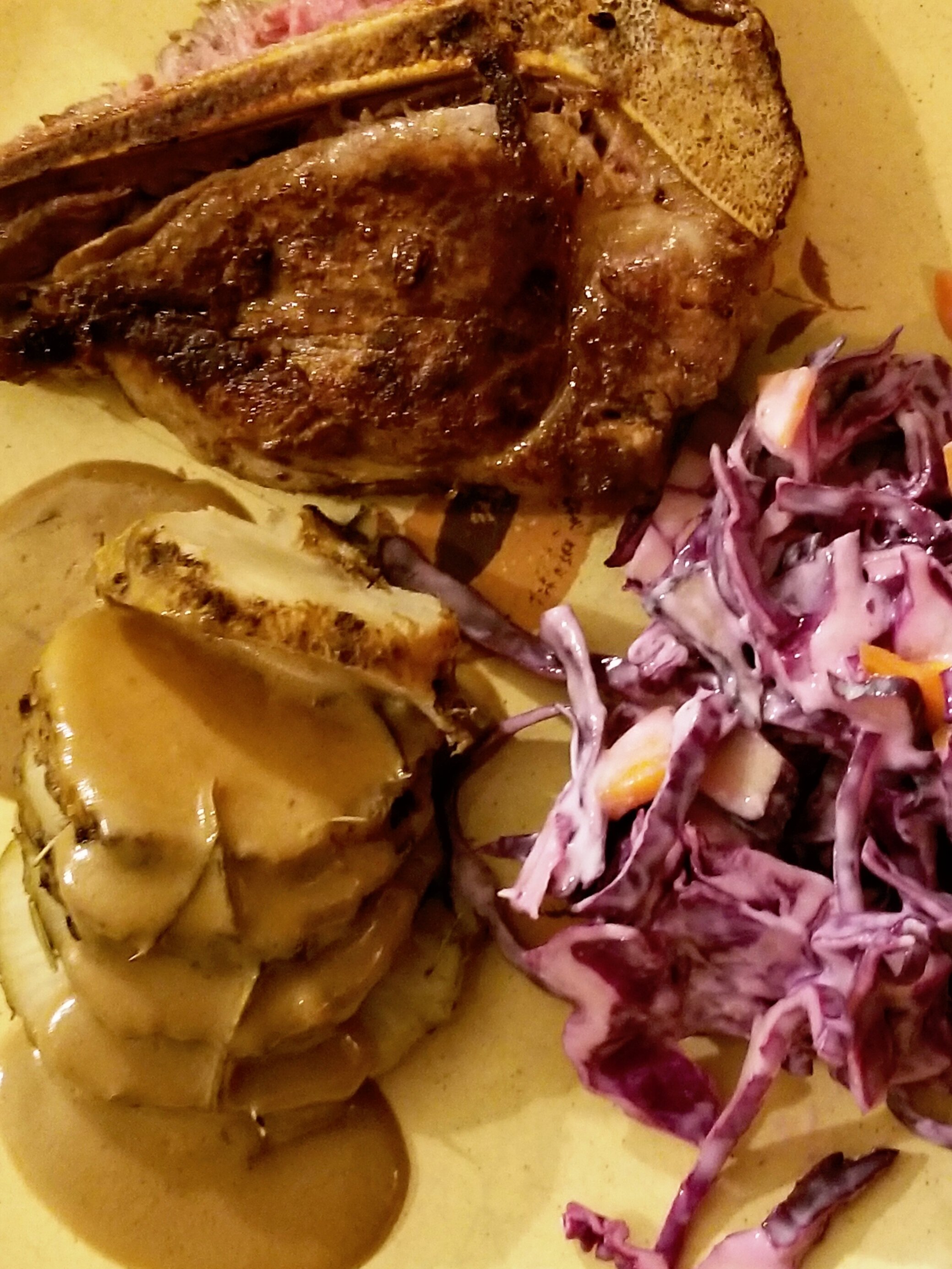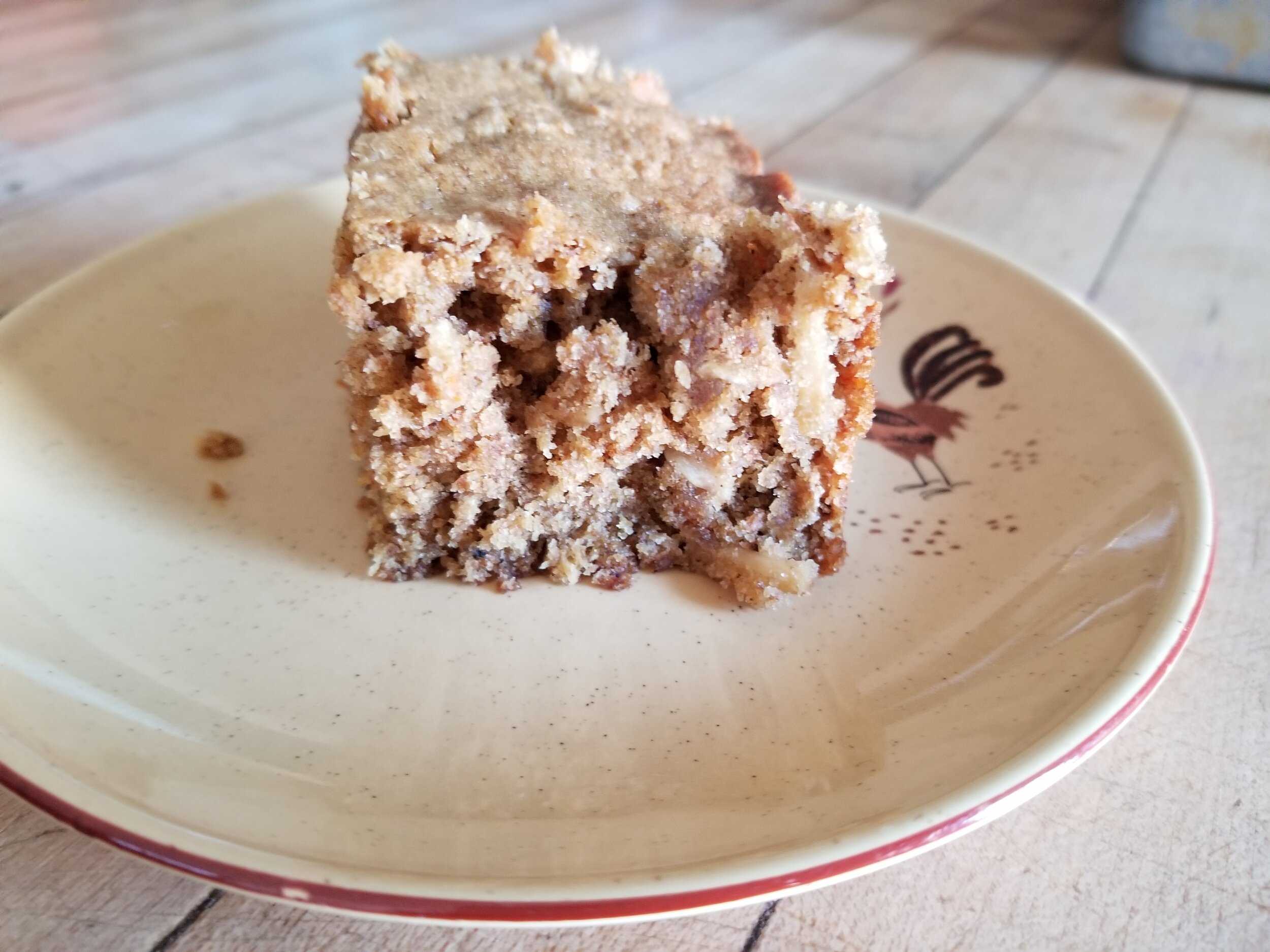This week I have been challenging myself to use celeriac in every meal, to try to get myself (and you, my social media followers) to appreciate celeriac, its versatility, its textures, and its flavors. This sprang out of a need to get our Winter Share members to take more celeriac, since we have a LOT in storage!
I have now had celeriac at 10 meals straight, and I am not sick of it. I’m here to share the ways I’ve used it, and the things I’ve learned.
Tacos with celeriac slaw
Celeriac and carrot slaw. This is a basic recipe that I use for many, many different vegetables and combinations of vegetables - straight carrot, a mix of kohlrabi, carrot, and radish, straight radish (I mean like Daikon radish, not the round red ones), celeriac, carrot, and radish, beet and carrot, beet and kohlrabi … I think the limitation here is, will the vegetable go through the food processor grater attachment? If yes, I will use it for slaw. All I do is grate up about 4 cups of veggies, transfer the grated veggies to a bowl large enough to mix in, then top with about half a cup of white wine vinegar (or rice vinegar, or plain white vinegar if that’s what you have, or apple cider vinegar if you’re in to that flavor!), 1 tablespoon of lime juice (or lemon if you prefer that flavor), and a teaspoon of salt (more or less to your taste). Mix well. Use as a topping, a side dish, or even the base of your meal if you are looking for low-carb and refreshing. If you use radishes in the mix, the leftovers will get kind of pungent after a day or two in the fridge, but the flavor doesn’t actually get much stronger (translation: your fridge will smell like farts) - the celeriac does not have this problem. If you use beets in the mix, the whole thing will be magenta!
Whole Roasted Celeriac with Pan Gravy
I followed this recipe: https://www.onegreenplanet.org/vegan-recipe/whole-roasted-celeriac-with-herbs-olive-oil-and-sea-salt/ except scaled up. I THOROUGHLY scrubbed 5 celeriac, put them in a 9x12 baking dish, generously drizzled them with oil (she says olive, but I used sunflower oil because my olive oil was solid - yes my pantry is that cold!), salt, and rosemary (although she calls for 3 T for one celeriac, and I did about that for all 5 and it was PLENTY), covered the pan tightly with foil, and then roasted at 375 F for about 90 minutes until fork-tender. I use this same technique to roast beets, which then peel very easily, but I did NOT peel the celeriac, just moved them to a cutting board and sliced them as if they were a roast. Because I had oiled them so generously, I also made a quick pan gravy, where I put the roasting pan on the stovetop, mixed together about a cup of milk/water (I did 50/50) with 2 tablespoons of flour, and whisked that in, whisking and simmering until it thickened up. I wish I had strained the gravy, because, as you can see in the picture, there was a LOT of rosemary in it, which wasn’t super fun to eat. I served this as the starch with a lovely cole slaw and a steak, but I can see that it would be a versatile dish at many different meals.
Breakfast hash. Put an egg on it!
Celeriac for breakfast. Here, I used the leftover slices of the whole roasted celeriac from the night before, some leftover sauteed shredded beets and carrots, and some leftover browned ground beef (taco filling). I fried them all together in a skillet, fried a couple eggs, and boom, a hearty, VERY satisfying breakfast! 10/10 would make again. Breakfast hash is a WONDERFUL way to use a wide variety of leftovers.
Reruns! But colorful reruns!
Sometimes the fridge is just too full of leftovers to justify making anything new. Plus, leftovers let you have a quick meal without a lot of work. The celeriac/carrot slaw went really well with the leftover cole slaw! Here served as a side dish rather than a taco topping.
Can you see the celeriac? My child can’t!
Carrot/celeriac quick bread. This recipe is a perennial favorite. The original recipe is a Zucchini bread recipe from the Schaghticoke Bicentennial Cookbook (thanks, Mom!). I have used this recipe for so many different fruits and vegetables, in a variety of combinations (apples/carrots, zucchini, winter squash, parsnips, and now celeriac/carrot!) - and you can also make it chocolate whatever bread by adding 3/4 cup of cocoa powder (I’ve only tested that with zucchini, which is really wet, so the resulting bread stays moist even with all that cocoa powder!), and you can throw in a cup of chocolate chips if you’re feeling ultra decadent.
This was dessert, as we went over to a friend’s house for dinner (shout out to Gwen http://massageatlux.com/ a wonderful massage therapist and a QUEEN of a human being!)
Here’s the recipe, as written:
2 cups sugar (I subbed 2 cups maple syrup; I’ve also done 1/2 c honey and 1 cup sugar)
1 cup oil (I used coconut oil in this instance; I’ve also done sunflower oil or melted butter)
3 eggs
1 teaspoon vanilla
1/2 teaspoon baking powder
1 teaspoon baking soda
1/2 teaspoon salt
1 teaspoon each ground ginger, cinnamon, and cloves (I even put these in if I’m adding the cocoa, just for the depth of flavor)
3 cups flour (I used Farmer Ground Flour all-purpose whole wheat - available in the bulk section at Honest Weight!)
2 to 3 cups grated zucchini (or whatever vegetable! For this, I did about 1 cup carrots and about 2 cups celeriac)
Mix all ingredients together, adding vegetable last after mixing all else. Pour into a well-greased 9x12 pan, 2 8x8 pans, or 2 loaf pans. Bake at 350 degrees F for about 1 hour (longer for a loaf!). You could also mix in nuts or raisins, I just don’t because my audience isn’t in to that (I would love these with about 1/2 cup walnuts! A little toothsome texture!)
A sweet version of breakfast celeriac.
The inspiration for this breakfast came as I was lying in bed, trying to convince myself to get up, and I thought, “is there such a thing as celeriac porridge?” so, of course, I Googled it. Here’s what I came across: https://cultureatz.com/andalusian-polea-porridge/?doing_wp_cron=1579795229.4968950748443603515625
This is not porridge made from celeriac, but rather topped with it. I decided that was something I could do. The article is fascinating, but I thought the porridge would not be a hit with my people, so I opted for our usual oatmeal. For the celeriac, I followed her instructions for roasting it. I peeled and chopped one celeriac into about 1/4”-1/2” cubes, spread them on a rimmed baking sheet, drizzled them with maple syrup and oil, and roasted at 375 until very golden and tender, about 30-45 minutes. I stirred them around every 15 minutes or so for even browning. I put them right on top of my regular old oatmeal - we like to eat our oats with peanut butter, yogurt, and maple syrup added. The celeriac was a nice addition to the oats, adding some variety to the texture and flavor.
Guest celeriac chef!
Lunch: celeriac/beet hash!
We have the distinct privilege of having a guest chef in our kitchen with great regularity. Frida, the associate director of Arts Letters and Numbers http://www.artslettersandnumbers.com/ in Averill Park, cooks our crew lunch at least once a month year round. This is such a joy for me, as she brings so much creativity to the kitchen, and she is unafraid of showing up and working with whatever is on hand, whether it’s leftovers or weird vegetables or meat she has never used before. Here is a layered hash, with the bottom layer made up of steamed celeriac and sauteed shallots, then topped with steamed beets, then eggs cracked in and the whole shebang put in the oven until the eggs were done. Frida doesn’t really work from a recipe, she just follows where the ingredients take her, so recreating her dishes is somewhat of a challenge, but generally a worthy one. There were NO leftovers.
dessert celeriac!
Here’s the pinnacle of my Celeriac Challenge: Celeriac Ice Cream. I followed this recipe from this lovely celeriac article from The Guardian: https://www.theguardian.com/lifeandstyle/2012/dec/14/celeriac-recipes-hugh-fearnley-whittingstall
The resulting ice cream is very scrumptious, but is truly a custard - it is quite eggy. It is actually the eggs that gave it this lovely yellow color, as the celeriac was very pale, especially after being simmered in milk for half an hour. I would definitely put celeriac in ice cream again, but I think I’d use my regular vanilla ice cream recipe (I love the Ben and Jerry’s recipe) and just add celeriac puree, to cut down on that egginess.
Is it breakfast or dessert?
So here’s the celeriac/carrot quick bread again, this time as BREAKFAST! Paired with Argyle Cheese Farmer’s plain yogurt (an essential in our house) and some strawberries from our garden that I froze in June, this becomes a filling breakfast, acceptable even to my tiny tyrant - she cleaned her plate.
As I said earlier, embracing leftovers is an essential part of being successful as a person who wants to prepare all the family’s meals with as little pre-processed food as possible. Consolidating your labor by making larger batches of things when you’re cooking, or preserving your harvest when you have the time so that it is easy to use when you don’t have the time, is a vital skill if you plan to be the sole chef for years. Sometimes leftovers are the key to retaining some sanity. Instead of making breakfast this morning, I did yoga while the sun rose, then pulled the yogurt and fruit out of the freezer and plunked quickbread on some plates while the coffee brewed. Now I have the energy to make a healthy lunch from raw ingredients!
Hash browns.
Celeriac Hash Browns - recipe here: https://www.bbcgoodfood.com/recipes/sage-celeriac-hash-browns
Grated celeriac and potatoes, mixed with minced onion (I used shallot, because I had it!), sage, egg, and cornmeal. A wonderful vessel for toppings of your choice - I have hot sauce, yogurt, pickles, still some of the leftover carrot/celeriac slaw, and leftover pan gravy from the roasted celeriac. You can’t really go wrong with those choices.
I am not sure how many more meals I’ll try to go in a row, but after a few days of this, I definitely admire celeriac for how versatile it is. I am eager to make this Celeriac and Hazelnut Soup: https://www.bbcgoodfood.com/recipes/celeriac-hazelnut-truffle-soup - that may be dinner, but we will see!
I will surely use celeriac more often now, after this self-imposed crash course in how to use it in any meal.
How have you used celeriac? What’s your favorite way to use it?










